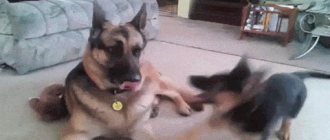A puppy's small age does not mean that he needs less attention and training.
Especially when it comes to German Shepherds.
This breed can become a true friend and protector.
But only if you start caring for and training him from a young age.
But this also has its own characteristics.
Let's find out about everything in detail.
Further in the article, detailed information on the care and education of a puppy will be provided.
What does a German Shepherd look like at 3 months?
At three months it becomes clearly visible that the puppy belongs to the German Shepherd breed. The dog's eyes and gaze become expressive. Other external parameters of a German puppy at 3 months include:
- The skull and body are proportional to each other, the frontal bone is slightly convex.
- The nose is bright black. German Shepherds are characterized by a small hump on their nose. Having noticed it in a puppy, you can be one hundred percent sure that this is a purebred German.
- Scissor bite of the anterior teeth.
- Ears begin to rise.
- Coarse, thick wool, colored in characteristic black and brown tones.
In addition, the puppy itself begins to quickly increase in size: its hind limbs and tail grow, its joints and muscles become more powerful. At three and a half months, the German cat sheds its first coat.
How to distinguish a breed from a crossbreed or mongrel
The surest way to purchase a purebred German Shepherd is to do so from a reliable kennel. Then the puppy will have a pedigree, a metric (puppy card), a brand with a unique number in the groin or on the ear. And you won’t have to guess whether you bought a purebred dog or not. When buying from private breeders or on the market, there is always a risk of making a mistake, because an amateur is unlikely to be able to correctly evaluate the breed. In this case, decide on the purpose: why you need a dog. To participate in exhibitions and breeding work, you need to look for a puppy only in nurseries with a good reputation. For official or security work - in the same place, because the character of a real German Shepherd, which made it a legend and a movie star, is also a sign of the breed. But then appearance is not so important, and the dog will cost much less.
The new owner signs the puppy inspection report (below) and the certificate is certified with a seal
If you want to have a companion dog with the appearance of a German Shepherd, then you can take the risk of purchasing it on the market or through “buy and sell” advertisements, but at the same time remember that a grown-up pet may unpleasantly surprise you with its difference from true “Germans”. There are signs by which you can try to distinguish a purebred puppy from a mestizo or mongrel:
- “Germans” have almond-shaped eyes with snow-white whites, while mongrel dogs have round, sometimes convex, eyes with yellowish whites or dark spots;
- an ordinary puppy cannot boast of a perfectly smooth topline and a body elongated like a torpedo;
- the tail of a small shepherd never rises above the line of the back and does not curl into a ring, like that of mongrels;
- The ears of a “German” should be floppy and soft for at least 4–5 months, while a mongrel’s ears may stand up at any time or not at all;
- A purebred baby does not have a stripe between the eyebrows (frontal furrow) on the forehead, but a purebred baby may have one;
- A shepherd puppy grows and develops much faster than a yard puppy, so at the same age he will weigh more and look more mature.
A “German” puppy is more inclined to communicate with a person than a mongrel puppy
Video: how to choose the right German Shepherd
Dog character and behavior
Although the three-month-old German Shepherd is slowly starting to mature, she is still a child. Therefore, constant pampering and restlessness are her faithful companions. At 3 months old, he needs somewhere to put his energy.
It is important at this age to show mastery persistence and explain to the child what behavior is inappropriate. Otherwise, the four-legged “rocket” will ruin all the things in the house, including furniture.
At 3 months, it’s time to teach the black German Shepherd to respond appropriately to random passers-by, other dogs and animals. But you don’t need to take your baby to noisy and crowded places for this. After all, his psyche is just beginning to form, and such a situation will make the German timid and twitchy.
How to care for your pet?
- To keep your pet healthy, regular hygiene is necessary. Ears are cleaned once every two weeks.
To do this, apply a special product to a cotton pad and gently clean the ear. If the color of the discharge is yellow, it means everything is in order. But if the discharge is dark in color, contains pus, or has an unpleasant, pungent odor, contact your veterinarian. - You need to brush your shepherd twice a week. If the molting period has arrived - every day.
- Pay attention to your eyes. Dogs of this breed are not prone to eye diseases, but if you notice purulent discharge, redness or swelling, contact a specialist immediately.
- At the age of 2 months, begin to accustom your shepherd to cutting his nails. Lay the animal on its side or sit it down. Fix the chosen position and remove 2-3 mm of the nail with a special tool. Be careful not to touch the blood vessels. If you get it and start bleeding, treat the nail with peroxide.
- During the year, the dog is taken for vaccinations three times.
- At 1 month of age, begin introducing complementary foods. This can be either dry specialized food, soaked in water, or chopped, lean meat (rabbit, turkey). Kefir and cottage cheese are also allowed. Upon reaching 1.5 months, introduce porridge (rice and oatmeal). The meat can be cut into small pieces.
By the 3rd month it is necessary to introduce vegetables. First boiled, and after some time - raw.Number of meals:
- up to 2 months – 6 times;
from 2-3 months – 5 times;
- from 3-6 months – 3 times;
- from 6 months – 2 times.
Feeding a 3 month old German Shepherd puppy.
The daily diet of a German Shepherd puppy can be natural food and dry food. Which of the two options is better is up to the dog owner to decide.
Natural feeding
To feed your Black Longhaired German Shepherd puppy natural food correctly, it is important to follow a whole list of rules:
- The food served should be at room temperature. Do not give your baby hot or cold food.
- You need to cut food into small pieces. Puppies sometimes choke on large pieces, because Germans do not chew their food, but swallow it whole.
- It is necessary to establish the same feeding time every day.
- The dog should not be allowed to overeat. Among the consequences of overfeeding are intestinal volvulus and severe dehydration.
- Every day you need to change the drinking water in the bowl and place it in an accessible place.
The composition of a natural menu for a three-month-old puppy must contain:
- Maximum meat. Thanks to protein, the dog grows quickly and develops properly. A German needs lean beef, turkey, rabbit and chicken (if there are no allergies). You should not give your dog pork.
- Carbohydrates. These are different porridges: buckwheat, rice, millet, rolled oats.
- Fiber. These are vegetables (beets, fresh cucumber, cabbage, zucchini) and fruits (apples). It is preferable to give your puppy raw vegetables so that they retain maximum vitamins.
- The German Shepherd is allowed to give cottage cheese, kefir and yogurt. The main thing is a low fat percentage.
Dry food
Choosing dry food for a 3-month-old German Shepherd is a responsible task. So, when purchasing ready-made granules, you should rely on their composition, class and purpose:
- Economy and premium food is not suitable for a German Shepherd puppy. You need a super-premium or holistic.
- It is important that the dry food is intended specifically for the German Shepherd breed.
- You need to buy age-appropriate granules.
- The composition should not contain artificial additives.
The advantages of dry food are its balance and ease of use. When feeding natural food, it is difficult for the owner to balance the content of vitamins and minerals.
Mixed nutrition
Dry food cannot be mixed with natural food. This negatively affects the gastrointestinal tract of the German Shepherd.
What is better – natural or dry food?
Every owner thinks about which food is best for a pet. The debate over natural food and dry food never subsides.
Each of these foods can meet the needs of the puppy, the main thing is to follow the most important instructions in feeding the dog:
- When choosing dry food, opt for premium or super-premium class;
- Try to choose food for your breed;
- The food must be suitable for the dog’s age;
- If you choose natural food, the dog’s diet should be balanced;
- Natural food will require special vitamins;
- You must approach the choice of products responsibly: buy only fresh ones, exclude those that will harm the dog.
Expert opinion
Kozhevin Semyon Kirillovich
Expert dog handler.
“Food for a puppy of this breed is a very important matter. I know that many owners who are professional breeders choose natural food, believing that it is healthier for the dog. But they have enough time to cook and buy all the necessary products. People who get a German Shepherd “for the soul, and not “for business”, prefer dry food. If the dog's nutrition is correct, then no matter what type of food you choose, the dog will be happy."
Vitamin supplements for a puppy at three months
To avoid vitamin deficiency in a small German puppy, you need to give him vitamin supplements.
As a supplement to the natural diet, you need to feed your German with fresh greens, namely:
- parsley;
- spinach;
- scalded nettle;
- green onions;
- beet tops;
- salad.
Another natural vitamin supplement is sprouted grains. For example, oats or millet. To replenish the need for minerals, you need to give a 3-month-old German a meal made from meat and bones, crushed eggshells into powder.
Instead of natural vitamin supplements, you can buy special preparations at the veterinary store. In some cases they are even more effective.
Contacts with strangers
With proper upbringing of a puppy, his attitude towards other people (if they do not show aggression) will be a complete disregard for strangers.
This is achieved through the hard work of the owner:
- Firstly, prohibit everyone except family members from playing with the puppy, stroking it, calling it to you, touching it, etc.;
- Secondly, explain to anyone who wants to approach you or show any emotional actions towards your dog when you are walking with the puppy that this should not be done.
Achieve this. Unfortunately, many people do not understand the stages of raising a dog and perceive such a request as a personal insult. If the owner is a weakling (by character), then it will not be possible to instill the skill of concentration on the owner.
The best way to distract your puppy's attention from a stranger is to attract the dog with a piece of treat. In each case, when your puppy becomes interested in strangers, call the puppy softly, pull the leash towards you and reward him with a treat.
In this way you will discourage the puppy from showing interest in strangers. They will simply not be interesting to him.
When walking in new places, if the dog begins to get nervous, turn the attention to yourself in the same way.
Never allow strangers to feed your puppy. This way you will teach the dog to be interested in strangers and all your upbringing will go to waste.
Food prohibited for a puppy
It is not recommended to feed small German puppies at 3 months of age:
- Potatoes. It contains starch, which is poorly absorbed by the body of babies.
- Milk. Most babies are lactose intolerant at this age.
- Fried, pickled and smoked dishes.
- Sausage.
- Sausages.
- Bones of chicken and other birds. They damage the dog's esophagus and can also get stuck in the throat.
Any food from the human table is harmful for Germans at 3 months, as at any other age.
What not to feed
Under no circumstances should you feed your dog the following foods:
- Pork meat,
- Any bones
- Pasta,
- Bakery,
- Oranges, tangerines and lemons,
- Sausages, bacon, sausages and small sausages,
- Candies and chocolate,
- Pickled vegetables,
- I eat with spices
- Highly salty and spicy foods
- Beans and peas.
Otherwise, this food can lead to serious consequences: diarrhea, vomiting, stomach pain and increased gas formation, dehydration.
Care and maintenance at this age
Care includes maintaining hygiene and frequent walks.
Puppy hygiene includes:
- Regular combing of the animal's fur. This procedure should be carried out once or twice a week.
- Cleaning the ears. Sulfur and other contaminants must be systematically removed. The same goes for the German's eyes.
- Nail trimming.
- Periodic bathing. It is required only in extreme cases, when the pet begins to smell and is very dirty.
Walking a German Shepherd at three months should be done regularly. The first trips outside usually take about five minutes. Every day the time spent in the air increases until it reaches 30-40 minutes a day. It is imperative to use a leash when walking your German.
While walking, play active games with your pet; you need to allow him to communicate with the dogs of other owners. Sometimes you need to go jogging together.
When do teeth change?
The replacement of baby teeth begins in shepherd dogs between 12-14 weeks. Itching in the oral cavity is possible; to reduce it, you can give the puppy rubber toys or large bones. This will also help get rid of already loose baby teeth.
Attention! Some dogs experience fever and lethargy when they change teeth. If you notice that your pet is feeling unwell, then reduce walks and active games. Protect from stressful situations.
If you notice that a baby tooth is very loose, you can remove it yourself. When removing, pull the tooth upward to prevent damage. Firmly seated teeth should not be removed, as fragments may remain in the gums.
The change of canines occurs at the age of 4 months. At the age of 10 months, all of the dog’s teeth are molars.
Training and raising a puppy
At 3 months of age, a German Shepherd is already ready to learn and follow commands. First you need to learn the basic ones, which include the commands “Sit”, “Come to me”, “Lie down”.
The rules for training and educational work with German puppies are as follows:
- It is forbidden to shout at the dog, scold it or hit it. In this case, you can completely lose her respect and make the baby afraid of herself.
- Every correct action of a German puppy should be rewarded. You need to praise or treat your four-legged friend.
- You need to make sure that before classes your pet is in a good mood, he is full and does not want to go to the toilet.
- You need to conduct the lesson at the same time. This way the dog will develop a habit. Try to carry out training in a variety of places, which makes the puppy understand that it is necessary to carry out and listen to commands not only within one specific location.
After mastering the basic commands for a 3-month-old German Shepherd, it’s time to learn the following set: “Fu,” “Walk,” “Fetch.” Other interesting teams include “Own” and “Alien”.
Lack of education will make your little four-legged friend a real threat to all living things.
Walking mode
For full development, the puppy should walk outside more. Of course, only after all vaccinations. When he is small, he can be taken out 5-6 times a day for 15-20 minutes. He must get used to going outside to relieve himself, so it is necessary to walk him immediately after sleep, after eating, and before bed. The older he gets, the longer the walks should be. The walk should be combined with games and training. After a year, the German Shepherd can be given for special training - capture, training in the “face” command. This is not necessary in order to turn him into a bodyguard; the shepherd will already protect his owner in a critical situation. This is necessary so that she gets used to discipline and unquestioning submission. After all, a large dog that cannot be controlled is a very dangerous phenomenon.
Walks should ultimately be at least 1 hour in the morning and 2 hours in the evening. In order for the dog to be socially active and not afraid of city noises, you should take it on short trips, guests, and give the puppy the opportunity to run around with peers.
Training a puppy begins from 1 month of his life: the earlier he starts to exercise, the more flexible his brain will become and the deeper his intellect. The first command for a puppy is his name. Then he can be taught commands: place, fu, sit, lie down, voice, next to him. These and several other similar commands make it easier to control the puppy and are called a general training course (GTC). He can take a special training course at a canine club or training school after a year.
Due to the ideal balance of strength and intelligence, the German Shepherd has become an indispensable assistant and partner for a person in almost all areas of his activity. She can be an excellent shepherd or guard. Millions of dogs of this breed serve in the military, police and other law enforcement agencies. They are sappers, trackers, and customs officers.











